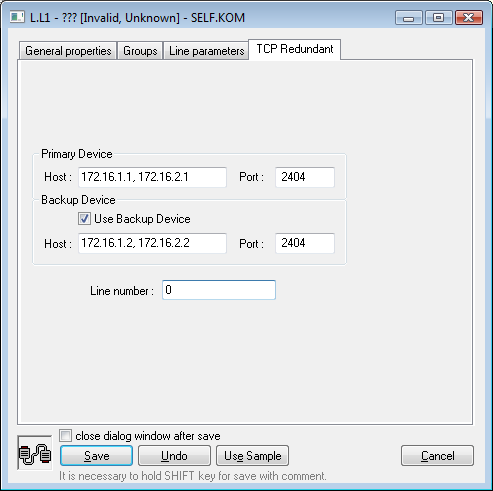Configuration of communication lines of TCP/IP-TCP and TCP/IP-TCP Redundant categories.
Lines of categories TCP/IP-TCP and TCP/IP-TCP Redundant were designed for the needs of communication
protocols which are built directly on TCP/IP. TCP/IP-TCP Redundant enables implementation of redundant communication
(redundant network lines, redundant network interfaces) and configuration of two IP addresses of
a communication partner.
Following protocols are supported at the present time:
Line TCP/IP-TCP
- IEC 870-5-104
- IEC 870-5-104 Server
- IEC 60870-6 ICCP/TASE.2
- KMZ Protocol
- MODBUS Client
- MODBUS Server
- Orange GDEP
- Siemens SIMATIC S7 ISO on TCP
- Siemens SAPHIR
- Teltonika Codec14
Line TCP/IP-TCP Redundant
- IEC 870-5-104 Sinaut
- IEC 870-5-104
- IEC 60870-6 ICCP/TASE.2
- Siemens SIMATIC S7 ISO on TCP
- Siemens SAPHIR
TCP/IP-TCP line configuration
Server - Host
IP address or network name of a computer. If the name is configured (and not an IP address in the format X.X.X.X), it will
be converted into IP address using the standard name resolution mechanism provided by OS (hosts, DNS, WINS ..).
If server protocol is configured,
IP address for KOM process to listen should be configured, i.e. IP address of one of the
computer network interfaces which KOM process runs on. Example: 127.0.0.1 or localhost (local interface), 192.16.0.1.
Note: It is possible to use a symbolic address ALL - in this case the KOM process listens on chosen TCP port
in
all network interfaces which are available.
If the configured protocol is not the server protocol, the IP address of the communication partner to which KOM process
connects should be configured.
Server - Port
If server protocol is configured, enter the number of TCP port which KOM process should listen on. Otherwise enter the number of TCP port of the communication partner to which KOM process should connect.
Line number
It is used for configuration of specific parameter in some protocols, in other protocols it is not used and it can be set to any numeric value (e.g. 0).
TCP/IP-TCP Redundant line configuration
Primary Device - Host
Primary IP address of the communication partner to which KOM process connects. If the name is configured (and not the IP address in the format X.X.X.X), it will be converted into IP address using a standard name resolution mechanism provided by OS (hosts, DNS, WINS ..).
Primary Device - Port
Number of the primary TCP port of the communication partner to which KOM process connects.
Use Backup Device
If this option is not selected, KOM process does not connect to backup IP address and the line works like a TCP/IP-TCP line, i.e. without redundancy.
Backup Device - Host
Secondary IP address of the communication partner to which KOM process connects. If the name is configured (and not an IP address X.X.X.X), it will be converted into IP address using the standard name resolution mechanism provided by OS (hosts, DNS, WINS ..).
Backup Device - Port
Number of a backup TCP port of the communication partner to which KOM process connects.
Note about entering the Host parameter
Parameter Host can contain several (up to 8) IP addresses or network names of computers separated by comma or semicolon, e.g.
172.16.0.1; 172.16.0.2 (spaces are permitted before and after the IP address due to readability). See the documentation of
a used communication protocol to find out whether it can utilize more than one IP address. For example the protocol
IEC 870-5-104: if several IP
addresses are configured (on TCP/IP-TCP or TCP/IP-TCP Redundant lines),
connection is initially established to first IP address. If the connection breaks, KOM
process tries to reconnect to second IP address, then to third etc.. After all
configured IP addresses are tried, it uses again the first IP address.
This configuration can be used if several communication partners exist and they either provide the same valid data
or only the one which is active, i.e. it communicates (and all others refuse the connections).
Other protocols (e.g. MODBUS Client) currently use only the first configured IP address.
Note about the redundancy of network communication
Currently only two protocols supporting the TCP/IP-TCP redundant line are implemented. Protocol IEC 870-5-104 Sinaut is a specific implementation of the protocol IEC104 designed for redundant communication with Sinaut Spectrum system. Much more frequently you can meet the protocol IEC 870-5-104, which has many options related to communication redundancy implemented.
Related pages:


0 komentárov